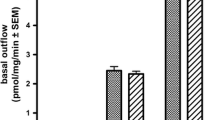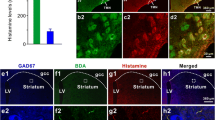Abstract
We sought to determine in rat striatum whether the release of neurotransmitter amino acids aspartate (Asp), glutamate (Glu) and gamma-aminobutyric acid (GABA) were affected by local neurons. To do so, unilateral microinjections of ibotenic acid, an excitotoxin that destroys local neurons without affecting fibers of passage, were made into the striatum. Release of endogenous amino acids from lesioned and intact striatal slices were measured by HPLC one week later. The effectiveness and specificity of the lesion were confirmed by measuring the enzyme activity associated with extrinsic dopamine neurons (tyrosine hydroxylase; 111±14%), intrinsic GABA neurons (glutamic acid decarboxylase; 19±7%) and intrinsic acetylcholine neurons (choline acetyltransferase; 37±10%). Destruction of local striatal neurons markedly attenuated the release of GABA (41±12% of control) elicited by depolarization with K+ (35 mM), but did not significantly reduce the K+-evoked release of Asp (80±17%) and Glu (92±8%). However, spontaneous release of Asp and Glu was significantly greater than that observed in unlesioned tissue (159±18% and 209±27%, respectively), while the spontaneous release of GABA was not significantly reduced (75±43%). Although release of the neurotransmitter amino acids Asp, Glu and GABA were affected by the lesion, the release of the non-neurotransmitter amino acid tyrosine was unaffected. These data are consistent with the hypotheses that: 1) the predominant source of releasable stores of endogenous Asp and Glu in the striatum arises from extinsic neurons, and 2) that the spontaneous release of Asp and Glu from axon terminals in the striatum may be regulated, at least in part, by local inhibitory neurons.
Similar content being viewed by others
References
Feger, J., Deniau, J. M., DeChamplain, J., and Feltz, P. 1979. A survey of electrophysiology and pharmacology of neostriatal input-output relations. Pages 71–104,in I. Divac and R. G. E. Oberg (eds.), The Neostriatum, Pergamon Press, New York.
Kitai, S., Kocsis, J. D., Preston, R. J., and Sugimori, M. 1976. Monosynaptic inputs to caudale neurons identified by intracellular injection of horseradish peroxidase. Brain Res. 109:601–606.
Graybiel, A. M., and Ragsdale, C. W. 1983. Biochemical anatomy of the striatum. Pages 427–504in P. C. Emson (ed.), Chemical Neuroanatomy, Raven Press, New York.
Reubi, J. C., and Cuenod, M. 1979. Glutamate release in vitro from corticostriatal terminals. Brain Res. 176:185–188.
Reubi, J. C., Toggenburger, G., and Cuenod, M. 1980. Asparagine as precursor for transmitter aspartate in corticostriatal fibers. J. Neurochem. 35:1015–1017.
Godukhin, O. V., Zharikova, A. D., and Novoselov, V. I. 1980. The release of labeledl-glutamic acid from rat neostriatum in vivo following stimulation of frontal cortex. Neurosci. 5:2151–2154.
Spencer, H. J. 1976. Antagonism of cortical excitation of striatal neurons by glutamic acid diethylester: Evidence for glutamic acid as an excitatory transmitter in rat striatum. Brain Res. 102:91–101.
Fonnum, F., and Storm-Mathisen, J. 1977. High affinity uptake of glutamate in terminals of corticostriatal axons. Nature 266:377–378.
Fonnum, F., Storm-Mathisen, J., and Divac, I. 1981. Biochemical evidence for glutamate as neurotransmitter in corticostriatal and corticothalamic fibres in rat brain. Neurosci. 6:863–873.
Butcher, S. P., and Hamberger, A. 1987. In vivo studies on the extracellular and veratrine-releasable, pools of endogenous amino acids in the rat striatum: Effects of corticostriatal deafferentation and kainic acid lesion. J. Neurochem. 48:713–721.
Fonnum, F., Soreide, A., Kvale, I., Walker, J. and Walass, I. 1981. Glutamate in cortical fibers. Pages 29–41,in G. DiChiara and G. L. Gessa (eds.), Glutamate As A Neurotransmitter, Raven Press, New York.
Hassler, R., Haug, P., Nitsch, C., Kim, J. S., and Paik, J. 1982. Effect of motor and premotor cortex ablation on concentrations of amino acids, monoamines and acetylcholine and on ultrastructure in rat striatum. A confirmation of glutamate as the specific cortico-striatal transmitter. J. Neurochem. 38:1087–1098.
Druce, D., Peterson, D., DeBelleroche, J., and Bradford, H. F. 1982. Differential amino acid neurotransmitter release in rat neostriatum following lesioning of the cortico-striatal pathway. Brain Res. 247:303–307.
Roberts, P. J., McBean, G. J., Sharif, N. A., and Thomas, E. M. 1982. Striatal glutamatergic function: modifications following specific lesions. Brain Res. 235:83–91.
Rowlands, G. J., and Roberts, P. J. 1980. Specific calcium-dependent release of endogenous glutamate from rat striatum is reduced by destruction of the cortico-striatal tract. Exp. Brain Res. 39:239–240.
Goduhkin, O. V., Zharikova, A. D., and Budantser, A. V. 1984. Role of presynaptic dopamine receptors in regulation of the glutamatergic neurotransmission in the rat neostriatum. Neurosci. 12:377–383.
Mitchell, P. R., and Doggett, N. S. 1980. Modulation of striatal [3H]glutamate release by dopaminergic drugs. Life Sci. 26:2073–2081.
Mitchell, R. 1980. A novel gaba receptor modulates stimulusinduced glutamate release from cortico-striatal terminals. Eur. J. Pharmacol. 67:119–122.
Potashner, S. J., and Gerard, D. 1983. Kainate-enhanced release ofd-[3H]aspartate from cerebral cortex and striatum: reversal by baclofen and pentobarbital. J. Neurochem. 40:1548–1557.
Hill, D. R., and Bowery, N. G. 1981.3H-Baclofen and3H-GABA bind to bicuculline-insensitive GABA-B sites in rat brain. Nature 290:149–152.
Rowlands, G. J., and Roberts, P. J. 1980. Activation of dopamine receptors inhibits calcium-dependent glutamate release form cortico-striatal terminals in vitro. Eur. J. Pharmacol. 62:241–242.
Schwarcz, R., Hökfelt, T., Fuxe, K., Jonsson, G., Goldstein, M., and Terenius, L. 1979. Ibotenic acid-induced neuronal degeneration: a morphological and neurochemical study. Exp. Brain Res. 37:199–216.
Amaral, D. G., and Price, J. L. 1983. An air pressure system for the injection of tracer substances into brain. J. Neurosci. Methods, 9:35–44.
Woo, J. I., Saji, M., Arnerić, S. P., and Reis, D. J. 1985. Neurochemical correlates of transneuronal cell loss of dopaminergic neurons of substantia nigra. Soc. Neurosci. Abst. 11. p. 1248.
Reis, D. J., Gilad, G. M., Pickel, V. M., and Joh, T. H. 1978. Changes in the activity and amount of tyrosine hydroxylase in dopamine neurons of the substantia nigra in response to axonal injury. Brain Res. 144:325–342.
Roberts, E., and Simonsen, D. G., 1963. Some properties ofl-glutamic acid decarboxylase in mouse brain. Biochem. Pharmacol. 12:133–134.
Fonnum, F. 1975. A rapid radiochemical method for the determination of choline acetyltransferase. J. Neurochem. 24:407–409.
Read, S. M., and Northcote, D. H. 1981. Minimization of variation in the response to different proteins of the Coomassie Blue G Dye-Binding Assay for protein. Anal. Biochem. 116:53–64.
Arneric, S. P., Meeley, M. P., and Reis, D. J. 1986. Somatostatin and CCK-8 modulate release of striatal amino acids: role of dopamine receptors. Peptides, 7:97–103.
Jones, B. N., Pääbo, S., and Stein, S. 1981. Amino acid analysis and enzymatic sequence determination of peptides by an improvedo-phthalaldehyde precolumn labeling procedure. J. Liquid Chromatog. 4:565–586.
Meeley, M. P., Underwood, M. D., Talman, W. T., and Reis, D. J. 1983. Content and in vitro release of endogenous amino acids in the area of the nucleus tractus solitarius (NTS). Soc. Neurosci. Abst. 9, p. 262.
Araki, M., McGeer, P. L., and McGeer, E. G. 1985. Differential effect of kainic acid on somatostatin, GABAergic and cholinergic neurons in the rat striatum. Neurosci. Letters 53:197–202.
Saji, M., and Reis, D. J. 1985. Evidence for transneuronal degeneration of dopamine neurons in the substantia nigra of the rat by destruction of neurons of caudate nucleus. Soc. Neurosci. Abst. 11, p. 1248.
Martin, D. L., Madelian, V., and Shain, W. 1985. Neurotransmitter-activated release of taurine from astrocytes. Am. Soc. Neurochem. 16:244.
Reis, D. J., Ross, R. A., and Joh, T. H. 1978. The reaction of central catecholamines to injury: model systems for studying the neurobiology of central regeneration and sprouting. Pages 197–226,in C. W. Cotman (ed.), Neuronal Plasticity, Raven Press, New York.
Jean-Philippe, P., Weiss, S., Sebben, M., Kemp, D. E., and Bockaert, J. 1986. Release of endogenous amino acids from striatal neurons in primary culture. J. Neurochem. 47:594–603.
Nicklas, W. J., Duvoisin, R. C., and Berl, S. 1979. Amino acids in rat striatum: alteration by kainic acid lesion. Brain Res. 167:107–117.
Aldinio, C., French, E. D., and Schwarez, R. 1981. Seizures and neuronal degeneration: relationships investigated by intrahippocampal kainic and ibotenic acid. Soc. Neurosci. Abst. 7, p. 589.
Frankhuyzen, A. L., and Mulder, A. H. 1977. Release of radiolabeled dopamine, serotonin, acetylcholine and GABA from slices of rat striatum after intrastriatal kainic acid injections. Brain Res. 135:368–373.
Fagg, G. E., and Foster, A. C. 1983. Amino acid neurotransmitters and their pathway in the mammalian central nervous system. Neurosci. 9:701–719.
Koller, K. J., Zaczek, R., and Coyle, J. T. N-Acetyl-aspartyl glutamate: regional levels in rat brain and the effects of brain lesions as determined by a new HPLC method. 1984. J. Neurochem. 43:1136–1142.
Author information
Authors and Affiliations
Rights and permissions
About this article
Cite this article
Arnerić, S.P., Woo, JI., Meeley, M.P. et al. Spontaneous release of endogenous aspartate and glutamate from rat striatal slices is increased following destruction of local neurons by ibotenic acid. Neurochem Res 13, 423–428 (1988). https://doi.org/10.1007/BF01268876
Accepted:
Issue Date:
DOI: https://doi.org/10.1007/BF01268876




